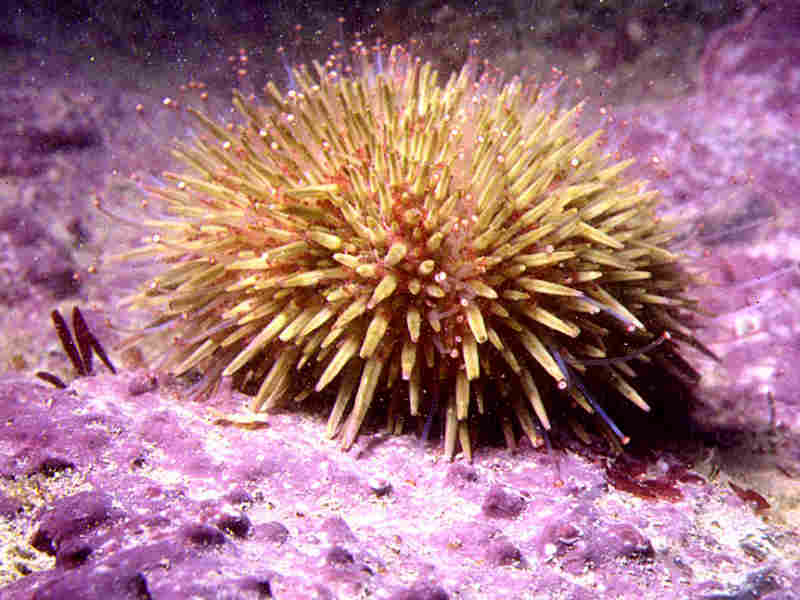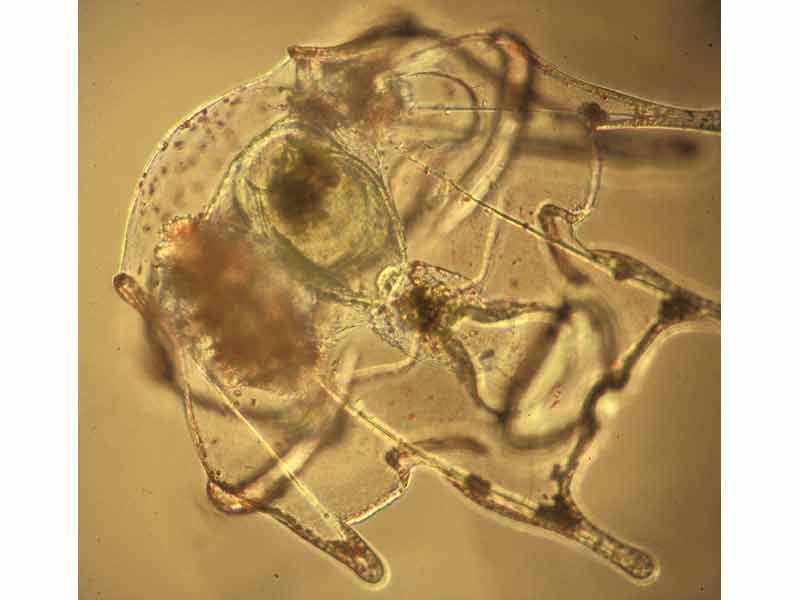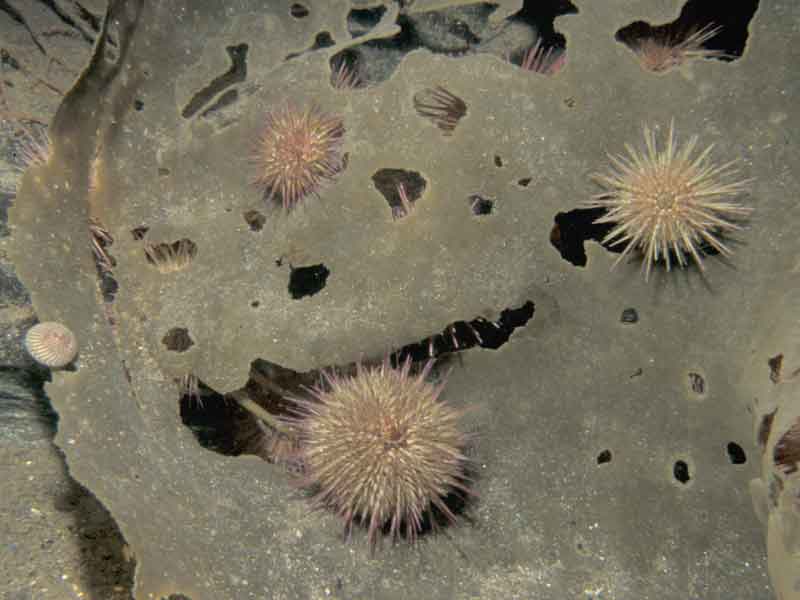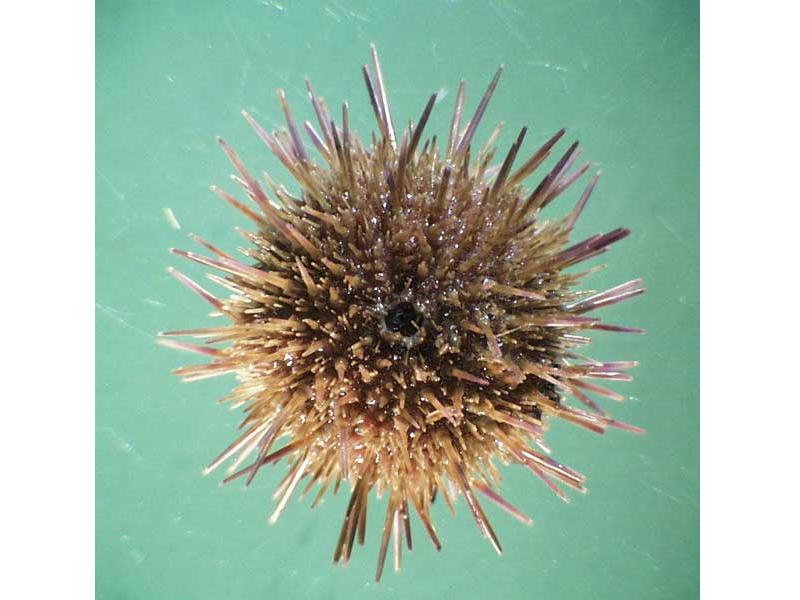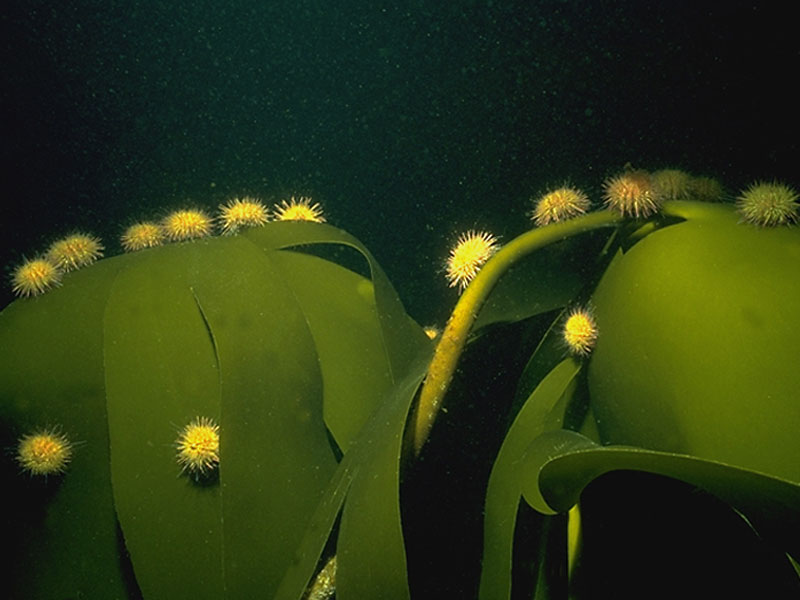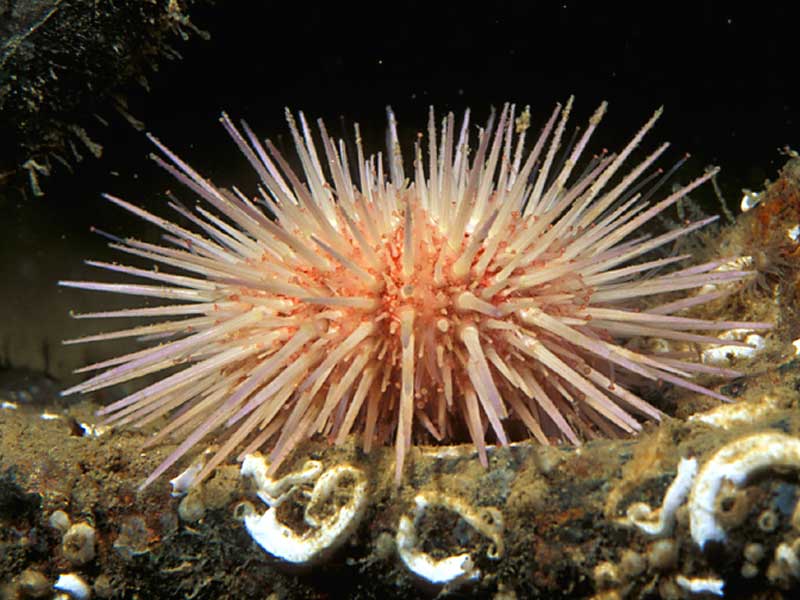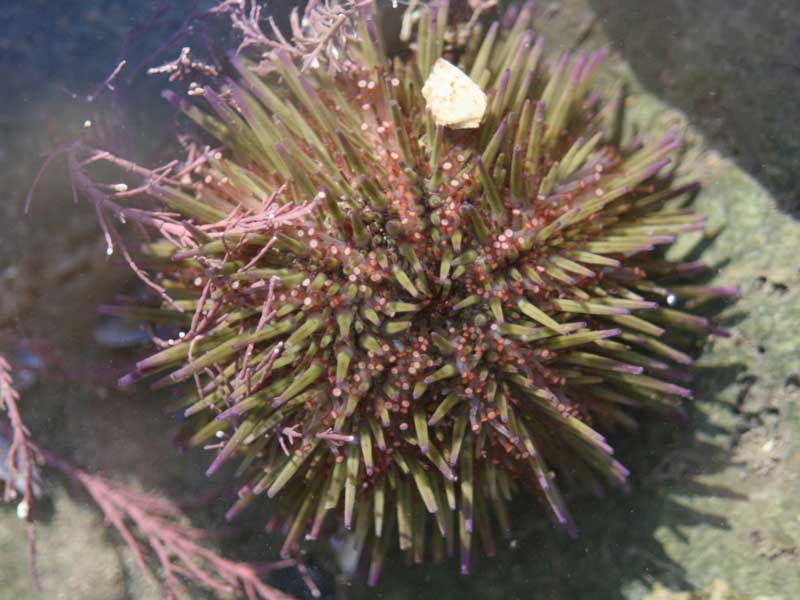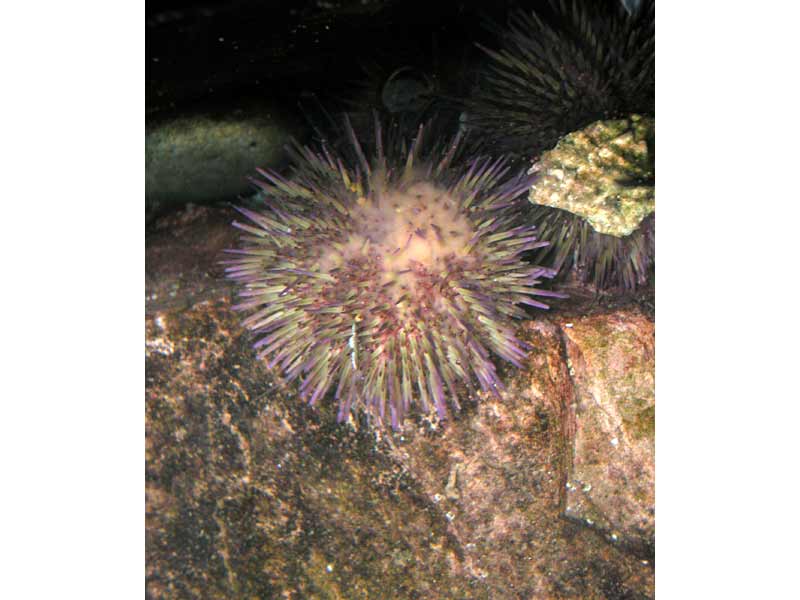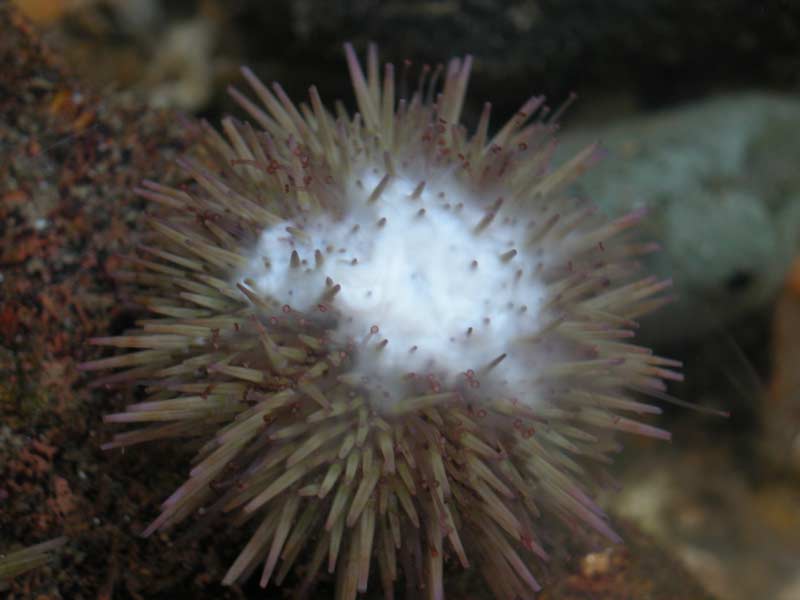Green sea urchin (Psammechinus miliaris)
Distribution data supplied by the Ocean Biodiversity Information System (OBIS). To interrogate UK data visit the NBN Atlas.Map Help
| Researched by | Angus Jackson | Refereed by | Dr Maeve Kelly |
| Authority | (P.L.S. Müller, 1771) | ||
| Other common names | - | Synonyms | - |
Summary
Description
An almost round, slightly flattened urchin that grows up to 57 mm in diameter (although more typically to 35 mm diameter). It is greenish in colour with distinctive violet tips to the spines. The spines are robust, short and closely packed.
Recorded distribution in Britain and Ireland
All British and Irish coasts. Evenly distributed in the southern North Sea but scarce in northern North Sea.
Global distribution
From Trondheim Fjord in northern Norway, inner Danish waters from the Skaw into the western Baltic, Iceland, British Isles, south to the Atlantic coast of Morocco and the Azores. Not in Greenland, the Mediterranean or Atlantic coasts of America.
Habitat
Found intertidally on rocky shores under stones, boulders and seaweeds especially Saccharina latissima. Also found subtidally in seagrass beds or on mixed coarse bottoms such as muddy sand and gravel.
Depth range
0 -100 mIdentifying features
- Test sub-pentagonal and slightly depressed, with short, robust spines.
- Greenish in overall colour with violet tips to the spines
- Ambulacral plates have three pore pairs and one primary tubercle.
- Globiferous pedicellariae abundant, jaw blades grooved, with a row of sharp spines along each side.
Additional information
- Sometimes called the purple tipped sea urchin. Older publications may refer to sea urchins as "burrs" (Hancock, 1957). Strongylocentrotus droebachiensis is also known as the green sea urchin. It is possible for Psammechinus miliaris to be confused with Strongylocentrotus droebachiensis or pale specimens of Paracentrotus lividus.
- A regular sea urchin with a somewhat flattened test. The colour varies with habitat (Bull, 1939; Lindahl & Runnström, 1929; Comely, 1979). Shallow water or littoral individuals are a deep purplish-brown and show no difference between the colour of the test and spines. Those from deeper water tend to be paler in colour, with a light green test and vivid purple spine tips.
- The tube-feet are arranged in arcs of 3, visible as 3 pairs of pores corresponding with each ambulacral plate on the denuded test.
- A typical species of bouldered sheltered shores, also found sublittorally in shallow water in sheltered or slightly brackish sites such as sea lochs. Common in the circalittoral on exposed shores in Shetland.
MarLIN would like to thank Dr Maeve Kelly for her comments and significant additions to the review.
Listed by
- none -
Biology review
Taxonomy
| Level | Scientific name | Common name |
|---|---|---|
| Phylum | Echinodermata | Starfish, brittlestars, sea urchins & sea cucumbers |
| Class | Echinoidea | Sea urchins, heart urchins and sand dollars |
| Order | Camarodonta | |
| Family | Parechinidae | |
| Genus | Psammechinus | |
| Authority | (P.L.S. Müller, 1771) | |
| Recent Synonyms | ||
Biology
| Parameter | Data | ||
|---|---|---|---|
| Typical abundance | High density | ||
| Male size range | Typically <4 cm | ||
| Male size at maturity | 8-10 mm | ||
| Female size range | 8-10 mm | ||
| Female size at maturity | |||
| Growth form | Globose | ||
| Growth rate | See additional information | ||
| Body flexibility | None (less than 10 degrees) | ||
| Mobility | Crawler or Walker, Mobile | ||
| Characteristic feeding method | Active suspension feeder | ||
| Diet/food source | Omnivore | ||
| Typically feeds on | Macroalgae, hydroids, bryozoans, boring sponges, barnacles, mussels, cockles and worms (see Lawrence, 1975). | ||
| Sociability | No information | ||
| Environmental position | Epifaunal | ||
| Dependency | Independent. | ||
| Supports | None See additional information. | ||
| Is the species harmful? | No See additional information | ||
Biology information
Abundance. In Scotland, Psammechinus miliaris typically occurs in dense, localized populations in sheltered areas of sea lochs on the west coast (Davies, 1989; Holt, 1991). Densities have been recorded of 18 individuals per 100 g dry weight of sea weed (Bedford & Moore, 1985); several /m² in beam trawls in the Wadden Sea (Cranmer, 1985); 34 individuals per m² in a subtidal Saccharina latissima (studied as Laminaria saccharina) bed, 182.4 /m² in a shallow bed of Zostera and 28.4 /m² on adjacent mud surfaces (Comely, 1979) and 352 /m² for littoral populations (Kelly, 2000) where individuals in one 0.25 m² quadrat ranged from 3.7 to 24.2 mm horizontal test diameter. Densities of several individuals /m² have been recorded in the German Waddensea (Ursin, 1960). Larsson (1968) found up to 10 individuals /m² in Saltkälle Fjord, Sweden.
Size. The maximum size varies with location. In some places, the maximum diameter reached is small (<2 cm (Jensen, 1969); around 3.5 cm (Bedford & Moore, 1985; Gage, 1991; Bull, 1939) although others have recorded diameters up to 5.75 cm (Allain, 1978) or up to 5 cm (Massin, 1999b; Aquascope, 2000a). The minimum diameter at maturity recorded (Brattström, 1941 cited in Jensen, 1969) is 6 to 7 mm but more usually 8 to 10 mm.
Growth rates. Estimates of growth rate vary. Gage, (1991) tried to relate growth bands found in the calcified plates of the test to seasonal differences in skeletal growth rate. This approach can be used reasonably accurately for estimating the age of young urchins. However, when growth slows down, the reduced distance between bands makes it difficult to distinguish individual markings. Bull (1939) recorded growth up to 2 cm test diameter in the first year which then slowed considerably. In the second year mean diameters increased from 2 to 2.62 cm and by the sixth year saw growth of only a further 1.2 cm or so. Jensen (1969) found that newly settled urchins (in August) grew 2 mm in the first two months and had reached 5.8 mm by the following July. Growth was recorded as maximal in spring and early summer by Gage (1991) and Bedford & Moore (1985) but work by Jensen (1969) showed no growth between May and October. Growth rates of cultivated Psammechinus miliaris are given by Cook et al. (1998).
Locomotion. Locomotion is mediated by the movable spines attached to the test. The echinoid test is very brittle and easily damaged by impact. The spines which are articulated at the base and controlled by muscles may provide some cushioning to impact but overall the flexibility is negligible.
Feeding. Psammechinus miliaris has been recorded as feeding on a wide variety of species (see Lawrence, 1975). Loose lying brown macroalgae, particularly Saccharina latissima (studied as Laminaria saccharina), is probably the main nutrient source although softer green algae such as Ulva lactuca may be important when small (Cook et al., 1998). The green sea urchin also feeds on epifauna such as hydroids, barnacles, small bivalves, boring sponges (e.g. Cliona), and worms (e.g. Polydora) (Hancock, 1957; Lawrence, 1975).
Parasites. Psammechinus miliaris (as well as other echinoderms) frequently harbours a polychaete, Flabelligera affinis amongst the spines.
Use. The gonads of Psammechinus miliaris, but more commonly Paracentrotus lividus, are eaten as a delicacy in Mediterranean countries. As wild populations of Psammechinus miliaris typically have small gonads, its potential for aquaculture is being investigated (Kelly et al., 1998).
Habitat preferences
| Parameter | Data |
|---|---|
| Physiographic preferences | Offshore seabed, Open coast, Ria or Voe, Sea loch or Sea lough, Strait or Sound |
| Biological zone preferences | Lower circalittoral, Lower eulittoral, Lower infralittoral, Mid eulittoral, Sublittoral fringe, Upper circalittoral, Upper infralittoral |
| Substratum / habitat preferences | Artificial (man-made), Bedrock, Cobbles, Gravel / shingle, Large to very large boulders, Macroalgae, Mixed, Muddy gravel, Muddy sand, Rockpools, Small boulders, Under boulders |
| Tidal strength preferences | Moderately strong 1 to 3 knots (0.5-1.5 m/sec.) |
| Wave exposure preferences | Extremely sheltered, Moderately exposed, Sheltered, Very sheltered |
| Salinity preferences | Full (30-40 psu), Variable (18-40 psu) |
| Depth range | 0 -100 m |
| Other preferences | No text entered |
| Migration Pattern | Non-migratory or resident |
Habitat Information
The species is found in the intertidal and subtidal, occasionally as deep as 100 m (Mortensen, 1927) but more commonly between 16 -70 m (Cranmer, 1985) or 0 -10 m in Scottish sea lochs (Kelly, 2000). On the west coast of Scotland, Psammechinus miliaris typically occurs in dense, localized populations in sheltered areas of sea lochs (Davies, 1989; Holt, 1991). Its distribution frequently coincides with that of the brown seaweed Saccharina latissima, with Psammechinus miliaris occurring on the fronds as well as on rock surfaces below the fronds. Some populations are exposed to air at low spring tides and are found attached to the underside of rocks, boulders and seaweed, or shallowly buried under gravel on the foreshore (Kelly, 2000). Individuals from the intertidal and subtidal habitats on the west coast of Sweden were termed 'Z' and 'S' forms by Lindahl & Runnström (1929). The 'Z' form lived in the 'seaweed region' and was larger and darker than the 'S' forms found at greater depths. Comely (1979) described a population of Psammechinus miliaris from a Zostera marina bed in a stable salinity, shallow, inlet in Loch Sween, Scotland. These individuals were found on the bottom mud and attached to the rhizomes of Zostera at depths of 1 to 2 m. Very young individuals have been found in the holdfasts of Laminaria from the Clyde Sea, Scotland (Moore, 1971). Psammechinus miliaris is often found on man-made surfaces such as bridge supports and wrecks.
Life history
Adult characteristics
| Parameter | Data |
|---|---|
| Reproductive type | Gonochoristic (dioecious) |
| Reproductive frequency | Annual protracted |
| Fecundity (number of eggs) | >1,000,000 |
| Generation time | 1 year |
| Age at maturity | 1 year |
| Season | May - October |
| Life span | 5-10 years |
Larval characteristics
| Parameter | Data |
|---|---|
| Larval/propagule type | - |
| Larval/juvenile development | Planktotrophic |
| Duration of larval stage | 1-2 months |
| Larval dispersal potential | Greater than 10 km |
| Larval settlement period | Insufficient information |
Life history information
Longevity. Gage (1991) tried to use skeletal growth bands to estimate the age of urchins but this approach proved to be difficult to use in older specimens due to the proximity of growth lines during slow growth in older individuals. Bull (1939) estimated longevity to be up to six years, Jensen (1969) up to eight years and Alain (1978) up to 10 or 12 years.
Maturity. Elmhirst (1922; cited in Gage, 1991) noted that maturity was reached in the first year after settlement. In contrast, Jensen (1969) found 75% of one-year-old urchins to have immature gonads in their first summer. However, Kelly (2001) noted that one-year-old Psammechinus miliaris produced viable gametes and were able to breed in the laboratory.
Spawning (see images). Individuals have been recorded as having ripe gonads from as early as February to as late as November (Orton, 1923; Sukarno et al., 1979; Mortensen, 1927). Actual breeding occurs in spring and early summer (Mortensen, 1927; Sukarno et al., 1979; Kelly, 2000). Psammechinus miliaris is a broadcast spawner (Massin, 1999(b)). The spawning period has been reported to be June to August in the Clyde Sea area (Elmhirst, 1922); June to October near Bergen, Norway (Runnström, 1925; cited in Lindahl & Runnström, 1929); June to October and May to October in West Norway and Denmark (Jensen, 1969); and July and August on the west coast of Scotland (Comely, 1979). Psammechinus miliaris from two typical habitats (littoral and sublittoral) on the west coast of Scotland had a defined annual cycle of gametogenesis with a single spawning period (Kelly, 2000) and gonad indices that peaked in June and July.
Fecundity. Estimates of fecundity suggest that females produce between 80,000 and 2,500,000 eggs in a single spawning event (Dr Maeve Kelly, unpublished observations). Breeding probably occurs over a couple of months (Kelly, 2000) but whether individuals breed for this entire period or whether this duration is for a whole population is uncertain. Orton (1923) suggests there is no evidence for collective spawning.
Sensitivity review
The MarLIN sensitivity assessment approach used below has been superseded by the MarESA (Marine Evidence-based Sensitivity Assessment) approach (see menu). The MarLIN approach was used for assessments from 1999-2010. The MarESA approach reflects the recent conservation imperatives and terminology and is used for sensitivity assessments from 2014 onwards.
Physical pressures
Use / to open/close text displayed
| Intolerance | Recoverability | Sensitivity | Evidence / Confidence | |
Substratum loss [Show more]Substratum lossBenchmark. All of the substratum occupied by the species or biotope under consideration is removed. A single event is assumed for sensitivity assessment. Once the activity or event has stopped (or between regular events) suitable substratum remains or is deposited. Species or community recovery assumes that the substratum within the habitat preferences of the original species or community is present. Further details EvidencePsammechinus miliaris lives and feeds on a variety of substrata. Loss of substratum will cause mortality. Adult urchins are mobile but probably not active over large distances so recolonization is unlikely to occur through adult immigration. Psammechinus miliaris is quite long lived (up to 12 years) (Allain, 1978), and can breed within one year of settlement (Kelly, 2001). Breeding occurs in spring and summer each year (Mortensen, 1927; Sukarno et al., 1979; Kelly, 2000), fecundity is likely to be high (MacBride, 1903) and the larvae are long lived (20-40 days) (Jensen, 1969; Massin, 1999b; Kelly et al., 2000). Dispersal potential is therefore large and recoverability is likely to be high. | High | High | Moderate | High |
Smothering [Show more]SmotheringBenchmark. All of the population of a species or an area of a biotope is smothered by sediment to a depth of 5 cm above the substratum for one month. Impermeable materials, such as concrete, oil, or tar, are likely to have a greater effect. Further details. EvidencePsammechinus miliaris is an epibenthic species that, although mobile, is not highly active and moves using mobile spines. This urchin species is quite small (typically up to 40 mm) and is likely to be completely covered by 5 cm of sediment. It is probable that the urchin would be unable to 'dig out' of the sediment. Adult urchins are mobile but probably not active over large distances so recolonization is unlikely to occur through adult immigration. Psammechinus miliaris is quite long lived (up to 12 years) (Allain, 1978), and can breed within one year of settlement (Kelly, 2001). Breeding occurs in spring and summer each year (Mortensen, 1927; Sukarno et al., 1979; Kelly, 2000), fecundity is likely to be high (MacBride, 1903) and the larvae are long lived (20-40 days) (Jensen, 1969; Massin, 1999b; Kelly et al., 2000). Dispersal potential is therefore large and recoverability is likely to be high. | High | High | Moderate | Low |
Increase in suspended sediment [Show more]Increase in suspended sedimentBenchmark. An arbitrary short-term, acute change in background suspended sediment concentration e.g., a change of 100 mg/l for one month. The resultant light attenuation effects are addressed under turbidity, and the effects of rapid settling out of suspended sediment are addressed under smothering. Further details EvidenceIt is unlikely that changes in siltation rate will have a great effect on this species. Psammechinus miliaris grazes on macroalgae and some encrusting faunal species so increases in siltation are unlikely to affect feeding. Increases in siltation rate will increase the amount of sediment settling out onto the urchin. There may be an increased energetic cost to clearing these particles. Energetic expenditure may result in loss of condition or compromise gonadal and somatic growth. On removal of the factor, recovery should take only a short time. | Low | Very high | Very Low | Low |
Decrease in suspended sediment [Show more]Decrease in suspended sedimentBenchmark. An arbitrary short-term, acute change in background suspended sediment concentration e.g., a change of 100 mg/l for one month. The resultant light attenuation effects are addressed under turbidity, and the effects of rapid settling out of suspended sediment are addressed under smothering. Further details Evidence | No information | |||
Desiccation [Show more]Desiccation
EvidencePsammechinus miliaris is found subtidally and intertidally. In intertidal regions the urchin is typically found in crevices and under boulders or weed where the risk of desiccation is minimized. However, relative humidity and temperature strongly influence survivorship of Psammechinus miliaris. Cook (1999) found that Psammechinus miliaris from littoral populations were more tolerant of an increased temperature and decreased relative humidity during aerial exposure than those from subtidal populations. Psammechinus miliaris from the littoral zone show slightly more tolerance to exposure at 60% relative humidity and 10 °C than those from sublittoral populations. At high relative humidity (95%), 95% of Psammechinus miliaris can withstand 72 hours exposure to air if kept chilled at 5 °C. But at 20 °C and 95% humidity, no Psammechinus miliaris survived 72 hours exposure (Cook, 1999; Dr Maeve Kelly, pers comm.). Therefore, it is likely that individuals exposed to an increase in desiccation at the benchmark level will die. Therefore, an intolerance of high has been recorded. Recruitment to the remaining population will probably occur by larval settlement from the plankton. Recoverability is likely to be high (see additional information). | High | High | Moderate | High |
Increase in emergence regime [Show more]Increase in emergence regimeBenchmark. A one hour change in the time covered or not covered by the sea for a period of one year. Further details EvidencePsammechinus miliaris is unlikely to be intolerant of changes in emergence regime. Although not highly active, the species is sufficiently mobile to be able to relocate to more suitable conditions. | Low | Low | Moderate | Low |
Decrease in emergence regime [Show more]Decrease in emergence regimeBenchmark. A one hour change in the time covered or not covered by the sea for a period of one year. Further details Evidence | No information | |||
Increase in water flow rate [Show more]Increase in water flow rateA change of two categories in water flow rate (view glossary) for 1 year, for example, from moderately strong (1-3 knots) to very weak (negligible). Further details EvidencePsammechinus miliaris holds itself onto the substratum using suction pads at the end of its tube feet (Massin, 1999b) Large increases in water flow rate may make it more difficult to remain on the substratum. The urchin Echinus esculentus has been observed to be 'rolled' by water currents (Comely & Ansell, 1988). Displacement from the substratum is unlikely to cause damage or death. Relocation back to a suitable or preferred location will incur an energetic cost. Energetic expenditure may result in loss of condition or compromise gonadal and somatic growth. On removal of the factor, recovery should take only a short time. | Low | Very high | Very Low | Low |
Decrease in water flow rate [Show more]Decrease in water flow rateA change of two categories in water flow rate (view glossary) for 1 year, for example, from moderately strong (1-3 knots) to very weak (negligible). Further details Evidence | No information | |||
Increase in temperature [Show more]Increase in temperature
For intertidal species or communities, the range of temperatures includes the air temperature regime for that species or community. Further details EvidenceThe species is recorded as occurring in water temperatures of between 4-17 °C. Ursin (1960) reported that Psammechinus miliaris had a high tolerance of low temperatures and that it is found in Limfjord, Denmark, where winter temperatures are just above zero. It reproduces in waters around the Faeroes where the summer temperatures seldom exceed 11 °C (Ursin, 1960). The geographical distribution of Psammechinus miliaris extends to the north and south of the British Isles into colder and warmer waters respectively. Consequently, long term chronic changes in temperature are unlikely to have a great effect on populations of Psammechinus miliaris in the British Isles. Therefore, an intolerance of low has been recorded. Recoverability is likely to be rapid. However, exposure to high temperatures in the intertidal will increase the risk of desiccation (see above). | Low | Low | Moderate | Moderate |
Decrease in temperature [Show more]Decrease in temperature
For intertidal species or communities, the range of temperatures includes the air temperature regime for that species or community. Further details Evidence | No information | |||
Increase in turbidity [Show more]Increase in turbidity
EvidenceMoore (1977) suggested that Echinus esculentus was unaffected by turbid conditions. Psammechinus miliaris can inhabit similar kelp habitats to Echinus esculentus and may be similarly tolerant. However, increased turbidity and resultant reduced light penetration is likely to affect macroalgal populations e.g. kelps, which are a preferred food species for Echinus esculentus. However, it can feed on alternative prey, detritus or dissolved organic material (Lawrence, 1975, Comely & Ansell, 1988). Conversely, decreases in turbidity may benefit algal growth. Reduced food availability may cause loss of condition or compromise gonadal and somatic growth. When food availability is returned to 'normal' recovery should take only a short time. | Low | Very high | Very Low | Moderate |
Decrease in turbidity [Show more]Decrease in turbidity
Evidence | No information | |||
Increase in wave exposure [Show more]Increase in wave exposureA change of two ranks on the wave exposure scale (view glossary) e.g., from Exposed to Extremely exposed for a period of one year. Further details EvidencePsammechinus miliaris occurs both in subtidally and inter-tidally from coasts all round the British Isles but is typically found in more sheltered environments. It has a lower tolerance of wave exposure than Echinus esculentus and Paracentrotus lividus, the latter being found on the exposed. It is likely that high levels of wave exposure limits the distribution of Psammechinus miliaris in the intertidal and subtidal (Dr Maeve Kelly, pers comm.). As Psammechinus miliaris feeds on a wide selection of algae and encrusting organisms (Lawrence, 1975) its distribution is thought to be limited more by physical parameters than food availability (Faller-Fritsch & Emson, 1972; cited in Lawrence, 1975). Therefore, an increase in wave exposure at the benchmark level is likely to remove at least a proportion of the population and an intolerance of intermediate has been recorded. Recruitment to the remaining population will occur by larval settlement from the plankton. Recoverability is likely to be high. | Intermediate | High | Low | Moderate |
Decrease in wave exposure [Show more]Decrease in wave exposureA change of two ranks on the wave exposure scale (view glossary) e.g., from Exposed to Extremely exposed for a period of one year. Further details Evidence | No information | |||
Noise [Show more]Noise
EvidenceNo evidence of sound or vibration reception in echinoids was found. | Tolerant | Not relevant | Not sensitive | Very low |
Visual presence [Show more]Visual presenceBenchmark. The continuous presence for one month of moving objects not naturally found in the marine environment (e.g., boats, machinery, and humans) within the visual envelope of the species or community under consideration. Further details EvidencePsammechinus miliaris is likely to have slight intolerance to visual disturbance. Like many other echinoids it avoids bright light (Massin, 1999(b)). This species is recorded as having a behavioural response to changes in shading. Sudden shading results in withdrawal of the tube feet (Millott & Yoshida, 1956) The degree of response depends on light intensity and the degree of intensity change. Other echinoid species are also recorded as having a shading response, with spines being brought round to point in the direction of the stimulus as a protective mechanism. The reaction is likely to be short lived and insignificant. This response may interfere with feeding and if this occurs repeatedly then loss of condition or reduced somatic and gonadal may result. On removal of the stimulus, recovery of condition should not take long. | Low | Very high | Very Low | Moderate |
Abrasion & physical disturbance [Show more]Abrasion & physical disturbanceBenchmark. Force equivalent to a standard scallop dredge landing on or being dragged across the organism. A single event is assumed for assessment. This factor includes mechanical interference, crushing, physical blows against, or rubbing and erosion of the organism or habitat of interest. Where trampling is relevant, the evidence and trampling intensity will be reported in the rationale. Further details. EvidenceThe test of Psammechinus miliaris is brittle and easily damaged by impact or abrasion. Spines and podia may be damaged or broken off. The spines may provide some degree of cushioning for the test. Beam trawling was reported to remove ca 20 to 50% of this species (Kaiser & Spencer, 1994a), and the impact of scallop dredging is likely to be similar. Damage to the test will generally be lethal, if not outright because internal organs become exposed to predators and possible infection. However, the frequency of occurrence of Psammechinus miliaris was reported to increase markedly over an 80 year period in trawled areas in the southern North Sea (Rumohr & Kujawski, 2000). Overall, the evidence from Kaiser & Spencer (1994a) suggests that a proportion of the population is likely to be removed and intolerance has been assessed as intermediate. Some repair and regrowth of minor damage to the test and spines may be possible. Recoverability is likely to be high (see additional information below). | Intermediate | High | Low | High |
Displacement [Show more]DisplacementBenchmark. Removal of the organism from the substratum and displacement from its original position onto a suitable substratum. A single event is assumed for assessment. Further details EvidencePsammechinus miliaris is mobile and may be also regularly displaced by wave action or water currents. Some damage may be caused by loss of tube feet during a displacement event but this is repairable. As with Echinus esculentus (Lewis & Nichols 1979b), displaced specimens are able to relocate. This will probably have negligible effect on the species. | Tolerant | Not relevant | Not sensitive | High |
Chemical pressures
Use [show more] / [show less] to open/close text displayed
| Intolerance | Recoverability | Sensitivity | Evidence / Confidence | |
Synthetic compound contamination [Show more]Synthetic compound contaminationSensitivity is assessed against the available evidence for the effects of contaminants on the species (or closely related species at low confidence) or community of interest. For example:
The evidence used is stated in the rationale. Where the assessment can be based on a known activity then this is stated. The tolerance to contaminants of species of interest will be included in the rationale when available; together with relevant supporting material. Further details. EvidenceConsiderable observations and work, mainly on Echinus esculentus but also on Psammechinus miliaris (Smith, 1968; Gomez & Miguez-Rodriguez, 1999; Dinnel et al., 1988 ) indicate high intolerance to synthetic contaminants. Newton & McKenzie (1995) state that echinoderms tend to be very intolerant of various types of marine pollution, but there is little more detailed information than this. Following the Torrey Canyon incident, large numbers of dead Psammechinus miliaris in the vicinity of Sennen, presumably due to the heavy spraying of dispersants in that area and exposure to the oil spill (Smith, 1968). Therefore, an intolerance of high has been reported. Recoverability is likely to be high (see additional information below). | High | High | Moderate | High |
Heavy metal contamination [Show more]Heavy metal contaminationEvidenceLittle is known about the effects of heavy metals on adult echinoderms although Newton & McKenzie (1995) state that echinoderms tend to be very sensitive to various types of marine pollution. In an area around Naples, with high concentrations of lead, zinc and copper, the urchins Paracentrotus lividus and Arbacia lixula were smaller than those at unpolluted sites further along the coast (Sheppard & Bellamy, 1974) probably due to either restricted growth or individuals dying before reaching adult size. Abundance was also lower in polluted sites and so intolerance of adults has been assessed as intermediate. Echinoderm larvae are know to be especially intolerant of heavy metals (Bryan, 1974). Recoverability is likely to be high (see additional information below). | Intermediate | High | Low | Low |
Hydrocarbon contamination [Show more]Hydrocarbon contaminationEvidenceEchinoderms seem especially sensitive to the toxic effects of oil, likely because of the large amount of exposed epidermis (Suchanek, 1993). Following the Torrey Canyon incident, large numbers of dead Psammechinus miliaris in the vicinity of Sennen, presumably due to exposure to the oil spill and the heavy spraying of hydrocarbon based dispersants in that area (Smith, 1968). Other significant effects have been observed in other species of urchins. For example, mass mortality of the echinoderm Echinocardium cordatum was observed shortly after the Amoco Cadiz oil spill (Cabioch et al., 1978) and reduced abundance of the species was detectable up to > 1000m away one year after the discharge of oil-contaminated drill cuttings in the North Sea (Daan & Mulder, 1996). In the Mediterranean around Naples, urchins were absent from areas which has visible signs of massive pollution of both sewage and oil. Echinus esculentus populations in the vicinity of an oil terminal in A Coruna Bay, Spain, showed developmental abnormalities in the skeleton. The tissues contained high levels of aliphatic hydrocarbons, naphthalenes, pesticides and heavy metals (Zn, Hg, Cd, Pb, and Cu) (Gomez & Miguez-Rodriguez 1999). But the observed effects may have been due to a single contaminant or synergistic effects of all present. However, it appears likely that echinoids such as Psammechinus miliaris are highly intolerant of hydrocarbon contamination. Recoverability is likely to be high (see additional information below). | High | High | Moderate | High |
Radionuclide contamination [Show more]Radionuclide contaminationEvidenceInsufficient | No information | No information | No information | Not relevant |
Changes in nutrient levels [Show more]Changes in nutrient levelsEvidenceIt is unlikely that changes in nutrient concentration will directly affect Psammechinus miliaris populations. The addition of nutrients may encourage the growth of ephemeral and epiphytic algae and therefore increase the food available to populations of grazing sea-urchins such as Psammechinus miliaris. Conversely, decreases in nutrient availability may limit growth of algae used as a nutrient source. Lawrence (1975) reported that sea urchins had persisted over 13 years on barren grounds near sewage outfalls, presumably feeding on dissolved organic material, detritus, plankton and microalgae, although individuals died at an early age. The ability to absorb dissolved organic material has been suggested by Comely & Ansell (1988). Reduced food availability may cause loss of condition or compromise gonadal and somatic growth. Increased food availability may cause the population to expand in number or extent. When food availability is returned to 'normal', recovery should take only a short time. | Low | Very high | Very Low | Moderate |
Increase in salinity [Show more]Increase in salinity
EvidenceEchinoderms are generally unable to tolerate low salinity (stenohaline) conditions and possess no osmoregulatory organ (Boolootian, 1966). There is some evidence for intracellular regulation of osmotic pressure due to increased amino acid concentrations. Populations of Psammechinus miliaris occur both in the sub-tidal and inter-tidal. The latter must encounter reduced salinity due to fresh water runoff or heavy rain and hence be able to tolerate variable salinity. Lindahl & Runnström (1929) showed through acclimatisation experiments that Psammechinus miliaris from the littoral (Z form) and sublittoral (S form) had different salinity optima. Gezelius (1962) showed that eggs from the Z and S forms of Psammechinus miliaris differed in the range of salinities they would tolerate and over which fertilization would successfully occur, 20-32 psu and 26-38 psu at 17-19 °C respectively. At low salinity urchins gain weight and the epidermis loses its pigment as patches are destroyed; prolonged exposure is fatal. Therefore, a short term acute decrease in salinity may cause mortality, especially in sublittoral populations, and an intolerance of intermediate has been recorded. Recoverability is likely to be high (see additional information below). | Intermediate | High | Low | Moderate |
Decrease in salinity [Show more]Decrease in salinity
Evidence | No information | |||
Changes in oxygenation [Show more]Changes in oxygenationBenchmark. Exposure to a dissolved oxygen concentration of 2 mg/l for one week. Further details. EvidenceUnder hypoxic conditions echinoderms become less mobile and stop feeding. Death of a bloom of the phytoplankton Gyrodinium aureolum in Mounts Bay , Penzance in 1978 produced a layer of brown slime on the sea bottom. This resulted in the death of fish and invertebrates, including Echinus esculentus, presumably due to anoxia caused by the decay of the dead dinoflagellates (Griffiths et al., 1979). Spicer (1995) investigated the effects of environmental hypoxia on the oxygen and acid-base status of Psammechinus miliaris. Oxygen uptake is not regulated by this species during progressive hypoxia. The habitat of this species includes rock pools on the shore that can experience quite severe hypoxia or even anoxia. Psammechinus miliaris must be able to tolerate low oxygen conditions provided the event is brief. In prolonged events, subtidal Psammechinus miliaris would presumably react in a similar fashion to the Echinus esculentus above. Recoverability is likely to be high (see additional information below). | Intermediate | High | Low | Moderate |
Biological pressures
Use [show more] / [show less] to open/close text displayed
| Intolerance | Recoverability | Sensitivity | Evidence / Confidence | |
Introduction of microbial pathogens/parasites [Show more]Introduction of microbial pathogens/parasitesBenchmark. Sensitivity can only be assessed relative to a known, named disease, likely to cause partial loss of a species population or community. Further details. EvidencePsammechinus miliaris is susceptible to 'Bald-sea-urchin disease', which causes lesions, loss of spines, tube feet, pedicellariae, destruction of the upper layer of skeletal tissue and death (Maes et al., 1986). It is thought to be caused by the bacteria Vibrio anguillarum and Aeromonas salmonicida. This disease has been recorded from Psammechinus miliaris from the French Atlantic coast. Although associated with mass mortalites of Strongylocentrotus franciscanus in California and Paracentrotus lividus in the French Mediterranean there is no evidence of mass mortalities of Psammechinus miliaris associated with this disease around Britain and Ireland. an intolerance of intermediate has therefore been recorded. Recoverability is likely to be high (see additional information below). | Intermediate | High | Low | Moderate |
Introduction of non-native species [Show more]Introduction of non-native speciesSensitivity assessed against the likely effect of the introduction of alien or non-native species in Britain or Ireland. Further details. EvidenceNo alien or non-native species is known to prey on, compete with or adversely (or otherwise) affect Psammechinus miliaris. | Tolerant | Not relevant | Not sensitive | Low |
Extraction of this species [Show more]Extraction of this speciesBenchmark. Extraction removes 50% of the species or community from the area under consideration. Sensitivity will be assessed as 'intermediate'. The habitat remains intact or recovers rapidly. Any effects of the extraction process on the habitat itself are addressed under other factors, e.g. displacement, abrasion and physical disturbance, and substratum loss. Further details. EvidencePsammechinus miliaris is now targeted as a potential aquaculture species since when fed a nutritious diet in culture, the gonad biomass rapidly proliferates (Kelly et al., 1998). A study of a littoral and sublittoral population, Kelly (2000) concluded that there was no evidence of an opportunity for a commercial fishery because of the low gonad content of wild populations. However, some extraction of Psammechinus miliaris may conceivably develop for roe-enhancement through feeding artificial or nutrient enriched diets (Dr Maeve Kelly pers comm.). Therefore, an intolerance of intermediate has been recorded. The aquaculture potential of this smaller species is being investigated (Kelly et al., 1998). Recoverability is likely to be high (see additional information below). | Intermediate | High | Low | Low |
Extraction of other species [Show more]Extraction of other speciesBenchmark. A species that is a required host or prey for the species under consideration (and assuming that no alternative host exists) or a keystone species in a biotope is removed. Any effects of the extraction process on the habitat itself are addressed under other factors, e.g. displacement, abrasion and physical disturbance, and substratum loss. Further details. EvidenceBoth sub-tidal and inter-tidal populations of Psammechinus miliaris are often intimately associated with macro algae, particularly with kelp beds, both attached and loose lying. Physical effects associated with removal of other species (such as kelp) are addressed in the relevant factors above. Therefore, extraction of seaweed species is likely to result in the loss of some individuals of Psammechinus miliaris. This species may also suffer as a result of trawling or dredging for other benthic species. Species with fragile tests such as urchins have been reported to be particuarly sensitive to damage from mobile fishing gear (see Jennings & Kaiser, 1998; Bergman & van Santbrink, 2000). Kaiser & Spencer (1994a) reported a ca 20 - 50% mortality in Psammechinus miliaris as a result of a single pass of an experimental 4 m beam trawl. However, the frequency of occurrence of Psammechinus miliaris was reported to increase markedly over an 80 year period in trawled areas in the southern North Sea (Rumohr & Kujawski, 2000). Overall, the evidence from Kaiser & Spencer (1994a) suggests that a proportion of the population is likely to be removed and intolerance has been assessed as intermediate. Recoverability is likely to be high (see additional information below). | Intermediate | High | Low | Moderate |
Additional information
Recoverability. Adult urchins are mobile but probably not active over large distances so recolonization is unlikely to occur through adult immigration. Psammechinus miliaris is quite long-lived (up to 12 years) (Allain, 1978), and can breed within one year of settlement (Kelly, 2001). Breeding occurs in spring and summer each year (Mortensen, 1927; Sukarno et al., 1979; Kelly, 2000), fecundity is likely to be high (MacBride, 1903) and the larvae are long-lived (20-40 days) (Jensen, 1969; Massin, 1999b; Kelly et al., 2000). Dispersal potential is therefore large and recoverability is likely to be high.
Importance review
Policy/legislation
- no data -
Status
| National (GB) importance | - | Global red list (IUCN) category | - |
Non-native
| Parameter | Data |
|---|---|
| Native | - |
| Origin | - |
| Date Arrived | - |
Importance information
- Psammechinus miliaris occurs in a diverse range of habitats, frequently at high densities, particularly in shallow or littoral location. Its is omnivorous (see Hancock, 1957; Lawrence, 1975). It is likely that the grazing activity of Psammechinus miliaris has a profound impact on the biodiversity and distribution of subtidal and intertidal encrusting invertebrates as well as flora. However, field studies that demonstrate the extent to which Psammechinus miliaris regulates the structure of these communities are lacking (Dr Maeve Kelly, pers comm.).
- Echinoderms such as Psammechinus miliaris and Echinus esculentus often provide shelter for a commensal species of bristle worm, Flabelligera affinis (Mortensen, 1927).
- Psammechinus miliaris is beginning to be cultivated for a substitute source of sea urchin gonads (formerly from Paracentrotus lividus), considered a delicacy in continental Europe. To accommodate this demand, investigations are being made into the feasibility of culturing Psammechinus miliaris, particularly into polyculture of this species in salmon farm cages (Kelly et al., 1998). This species appears to grow better when fed on artificial animal derived protein (salmon feed pellets) than when on a normal diet (Cook et al., 1998; Kelly et al., 1998). However, based on a study of a littoral and sublittoral population, Kelly (2000) concluded that there was no evidence of an opportunity for a commercial fishery because of the low gonad content of wild populations. However, some extraction of Psammechinus miliaris may conceivably develop for roe-enhancement through feeding artificial or nutrient enriched diets (Dr Maeve Kelly pers comm.).
- Psammechinus miliaris is predated upon by starfish, crabs and some fish, e.g.. the wolf fish Anarhichas lupus. Populations at low tide can be subject to predation by birds such as gulls and oyster catchers.
Bibliography
Allain, J-Y. 1978. Age et croissance de Paracentrotus lividus (Lamarck) et de Psammechinus miliaris (Gmelin) des côtes nord de Bretagne (Echinoidea). Cahiers de Biologie Marine, 19, 11-21.
Aquascope, 2000a. Green sea urchin. [on-line] http://www.vattenkikaren.gu.se/fakta/arter/echinode/psammili/psammie.html, 2000-09-21
Bedford, A.P. & Moore, P.G., 1985. Macrofaunal involvement in the sublittoral decay of kelp debris: the sea urchin Psammechinus miliaris (Gmelin)(Echinodermata: Echinoidea) Estuarine, Coastal and Shelf Science, 20, 19-40.
Bergman, M.J.N. & Van Santbrink, J.W., 2000b. Fishing mortality of populations of megafauna in sandy sediments. In The effects of fishing on non-target species and habitats (ed. M.J. Kaiser & S.J de Groot), 49-68. Oxford: Blackwell Science.
Boolootian, R.A.,1966. Physiology of Echinodermata. (Ed. R.A. Boolootian), pp. 822. New York: John Wiley & Sons.
Bruce, J.R., Colman, J.S. & Jones, N.S., 1963. Marine fauna of the Isle of Man. Liverpool: Liverpool University Press.
Bryan, G.W., 1984. Pollution due to heavy metals and their compounds. In Marine Ecology: A Comprehensive, Integrated Treatise on Life in the Oceans and Coastal Waters, vol. 5. Ocean Management, part 3, (ed. O. Kinne), pp.1289-1431. New York: John Wiley & Sons.
Bull, H.O., 1939. The growth of Psammechinus miliaris (Gmelin) under aquarium conditions. Report of the Dove Marine Laboratory, Series 6, 39-41.
Comely, C.A. & Ansell, A.D., 1988. Invertebrate associates of the sea urchin, Echinus esculentus L., from the Scottish west coast. Ophelia, 28, 111-137.
Comely, C.A., 1979. Observation on two Scottish West coast populations of Psammechinus miliaris. Scottish Marine Biological Association, Internal Report, Oban.
Cook, E.J., 1999. Psammechinus miliaris (Gmelin) (Echinodermata: Echinoidea): factors affecting its somatic growth and gonadal growth and development. , PhD thesis, Napier University, Edinburgh.
Cook, E.J., Bell, M.V., Black, K.D. & Kelly, M.S., 2000. Fatty acid compositions of gonadal material and diets of the sea urchins Psammechinus miliaris: Trophic and Nutritional Implications. Journal of Experimental Marine Biology and Ecology, 255, 261 - 274
Cook, E.J., Kelly, M.S., & McKenzie, J.D., 1998. Somatic and gonadal growth of the sea urchin Psammechinus miliaris (Gmelin) fed artificial salmon feed compared with a macroalgal diet. Journal of Shellfish Research, 17, 1549-1555.
Cranmer, G.J., 1985. Recent investigations into the distribution of regular echinoids in the North Sea. Journal of the Marine Biological Association of the United Kingdom, 65, 351-357.
Daan, R. & Mulder, M., 1996. On the short-term and long-term impact of drilling activities in the Dutch sector of the North Sea ICES Journal of Marine Science, 53, 1036-1044.
Davies, M., 1989. Surveys of Scottish Sealochs, Lochs A'Chairn Bhain, Glendhu and Glencoul. Joint Nature Conservation Committee, Peterborough. Marine Nature Conservation Review Report no. 983.
Dinnel, P.A., Pagano, G.G., & Oshido, P.S., 1988. A sea urchin test system for marine environmental monitoring. In Echinoderm Biology. Proceedings of the Sixth International Echinoderm Conference, Victoria, 23-28 August 1987, (R.D. Burke, P.V. Mladenov, P. Lambert, Parsley, R.L. ed.), pp 611-619. Rotterdam: A.A. Balkema.
Elmhirst, R., 1922. Notes on the breeding and growth of marine animals in the Clyde Sea area. Report of the Scottish Marine Biological Association, 19-43.
Gage, J.D., 1991. Skeletal growth zones as age-markers in the sea urchin Psammechinus miliaris. Marine Biology, 110, 217-228.
Gezelius, G., 1962. Adaptation of the sea urchin Psammechinus miliaris to different salinities. Zoologiska Bidrag fran Uppsala, 35, 329-337.
Gommez, J.L.C. & Miguez-Rodriguez, L.J., 1999. Effects of oil pollution on skeleton and tissues of Echinus esculentus L. 1758 (Echinodermata, Echinoidea) in a population of A Coruna Bay, Galicia, Spain. In Echinoderm Research 1998. Proceedings of the Fifth European Conference on Echinoderms, Milan, 7-12 September 1998, (ed. M.D.C. Carnevali & F. Bonasoro) pp. 439-447. Rotterdam: A.A. Balkema.
Griffiths, A.B., Dennis, R. & Potts, G.W., 1979. Mortality associated with a phytoplankton bloom off Penzance in Mounts Bay. Journal of the Marine Biological Association of the United Kingdom, 59, 515-528.
Hancock, D.A., 1957. The feeding behaviour of the sea urchin Psammechinus miliaris (Gmelin) in the laboratory. Proceedings of the Zoological Society of London, 129, 255-262.
Hayward, P., Nelson-Smith, T. & Shields, C. 1996. Collins pocket guide. Sea shore of Britain and northern Europe. London: HarperCollins.
Hayward, P.J. & Ryland, J.S. (ed.) 1995b. Handbook of the marine fauna of North-West Europe. Oxford: Oxford University Press.
Hinegardner, R., 1969. Growth and development of the laboratory cultured sea urchin. Biological Bulletin (Wood Hole), 137, 465-475.
Holt, R., 1991. Surveys of Scottish Sealochs, Lochs Laxford, Inchard, Broom and Little Loch Broom. Joint Nature Conservation Committee, Peterborough. Marine Nature Conservation Review Report no. 16.
Howson, C.M. & Picton, B.E., 1997. The species directory of the marine fauna and flora of the British Isles and surrounding seas. Belfast: Ulster Museum. [Ulster Museum publication, no. 276.]
Jennings, S. & Kaiser, M.J., 1998. The effects of fishing on marine ecosystems. Advances in Marine Biology, 34, 201-352.
Jensen, M., 1969. Breeding and growth of Psammechinus miliaris (Gmelin).
Kaiser, M.J., & Spencer, B.E., 1994a. A preliminary assessment of the immediate effects of beam trawling on a benthic community in the Irish Sea. In Environmental impact of bottom gears on benthic fauna in relation to natural resources management and protection of the North Sea. (ed. S.J. de Groot & H.J. Lindeboom). NIOZ-Rapport, 11, 87-94.
Kelly, M.S. & Cook, E.J., 2001. The ecology of Psammechinus miliaris. In Edible sea urchins: biology and ecology, (ed. J.M. Lawrence), pp. 217-224. Amsterdam: Elsevier Science.
Kelly, M.S., 2000. The reproductive cycle of the sea urchin Psammechinus miliaris (Echinodermata: Echinoidea) in a Scottish sea loch. Journal of the Marine Biological Association of the United Kingdom, 80, 909-919.
Kelly, M.S., 2001. Environmental parameters controlling gametogenesis in the echinoid Psammechinus miliaris. Journal of Experimental Marine Biology and Ecology, 266, 67-80.
Kelly, M.S., Brodie, C.C., & McKenzie, J.D., 1998. Somatic and gonadal growth of the sea urchin Psammechinus miliaris (Gmelin) maintained in polyculture with the Atlantic salmon. Journal of Shellfish Research, 17, 1557-1562.
Kelly, M.S., Hunter, A.J., Scholfield, C. & McKenzie, J.D., 2000. Morphology and survivorship of larval Psammechinus miliaris in response to varying food conditions. Aquaculture, 183, 233-240.
Kinne, O. (ed.), 1984. Marine Ecology: A Comprehensive, Integrated Treatise on Life in Oceans and Coastal Waters.Vol. V. Ocean Management Part 3: Pollution and Protection of the Seas - Radioactive Materials, Heavy Metals and Oil. Chichester: John Wiley & Sons.
Larsson, B.A.S., 1968. SCUBA-studies on vertical distribution of Swedish rocky-bottom Echinoderms. A methodological study. Ophelia, 5, 137-156.
Lawrence, J.M., 1975. On the relationships between marine plants and sea urchins. Oceanography and Marine Biology: An Annual Review, 13, 213-286.
Leighton, P., 1995. Contributions towards the development of echinoculture in North Atlantic waters with particular reference to Paracentrotus lividus (Lamarck). , PhD thesis, National University of Ireland, Galway.
Lewis, G.A. & Nichols, D., 1980. Geotactic movement following disturbance in the European sea-urchin, Echinus esculentus (Echinodermata: Echinoidea). Progress in Underwater Science, 5, 171-186.
Lindahl, P.E. & Runnström, J., 1929. Variation und Ökologie von Psammechinus miliaris (Gmelin). Acta Zoologica, 10, 401-484.
MacBride, E.W., 1903. The development of Echinus esculentus together with some points on the development of E. miliaris and E. acutus. Philosophical Transactions of the Royal Society of London, Series B, 195, 285-327.
Maes, P., Jangoux, M., & Fenaux, L., 1986. La maladie de l''oursin-chauve': Ultrastructure des lésions et charactérisation de leur pigmentation. Annales de l'Institut Océanographique. Nouvelle série, 62, 37-45.
Massin, C., 1999b. Psammechinus miliaris. http://staff.umh.ac.be/Sheridan.Richard/inventaire/ech/htm/psammechinus.htm, 2000-09-21
MBA (Marine Biological Association), 1957. Plymouth Marine Fauna. Plymouth: Marine Biological Association of the United Kingdom.
Millott, N., & Yoshida, M., 1956. Reactions to shading in the sea urchin Psammechinus miliaris (Gmelin). Nature, 178, 1300.
Moore, P.G., 1971. A study of pollution in certain marine ecosystems. , PhD thesis, University of Leeds, Leeds.
Moore, P.G., 1977a. Inorganic particulate suspensions in the sea and their effects on marine animals. Oceanography and Marine Biology: An Annual Review, 15, 225-363.
Mortensen, T.H., 1927. Handbook of the echinoderms of the British Isles. London: Humphrey Milford, Oxford University Press.
Newton, L.C. & McKenzie, J.D., 1995. Echinoderms and oil pollution: a potential stress assay using bacterial symbionts. Marine Pollution Bulletin, 31, 453-456.
Nichols, D., 1984. An investigation of the population dynamics of the common edible sea urchin (Echinus esculentus L.) in relation to species conservation management. Report to Department of the Environment and Nature Conservancy Council from the Department of Biological Sciences, University of Exeter.
Orton, J.H., 1923. The breeding period of Echinus miliaris. Nature, 111, 878-879.
Pantazis, P., Black, K.D., Connolly, J.G. & Kelly, M.S., 2000. The effect of artificial diets on growth, lipid utilisation and gonad biochemistry in the adult sea urchin Psammechinus miliaris. Journal of Shellfish Research, 19, 995 - 1002.
Rasmussen, E., 1973. Systematics and ecology of the Isefjord marine fauna (Denmark). Ophelia, 11, 1-507.
Rumohr, H. & Kujawski, T., 2000. The impact of trawl fishery on the epifauna of the southern North Sea. ICES Journal of Marine Science, 57, 1389-1394.
Shearer, C., de Morgan, W. & Fuchs, H.M., 1914. On the experimental hybridisation of echinoids. Philosophical Transactions of the Royal Society of London, Series B, 204, 255-373.
Sheppard, C.R.C. & Bellamy, D.J., 1974. Pollution of the Mediterranean around Naples. Marine Pollution Bulletin, 5, 42-44.
Smith, J.E. (ed.), 1968. 'Torrey Canyon'. Pollution and marine life. Cambridge: Cambridge University Press.
Spicer, J.I., 1995. Oxygen and acid-base status of the sea urchin Psammechinus miliaris during environmental hypoxia. Marine Biology, 124, 71-76.
Suchanek, T.H., 1993. Oil impacts on marine invertebrate populations and communities. American Zoologist, 33, 510-523. DOI https://doi.org/10.1093/icb/33.6.510
Sukarno, Jangoux, M., & van Impe, E., 1979. Le cycle reproducteur annuel de Psammechinus miliaris (Gmelin)(Echinoidea) en Zeeland. In Echinoderms: present and past (ed. M. Jangoux), Rotterdam: Balkema.
Ursin, E., 1960. A quantitative investigation of the echinoderm fauna of the central North Sea. Meddelelser fra Danmark Fiskeri-og-Havundersogelser, 2 (24), pp. 204.
Datasets
Centre for Environmental Data and Recording, 2018. IBIS Project Data. Occurrence dataset: https://www.nmni.com/CEDaR/CEDaR-Centre-for-Environmental-Data-and-Recording.aspx accessed via NBNAtlas.org on 2018-09-25.
Centre for Environmental Data and Recording, 2018. Ulster Museum Marine Surveys of Northern Ireland Coastal Waters. Occurrence dataset https://www.nmni.com/CEDaR/CEDaR-Centre-for-Environmental-Data-and-Recording.aspx accessed via NBNAtlas.org on 2018-09-25.
Environmental Records Information Centre North East, 2018. ERIC NE Combined dataset to 2017. Occurrence dataset: http://www.ericnortheast.org.ukl accessed via NBNAtlas.org on 2018-09-38
Fenwick, 2018. Aphotomarine. Occurrence dataset http://www.aphotomarine.com/index.html Accessed via NBNAtlas.org on 2018-10-01
Fife Nature Records Centre, 2018. St Andrews BioBlitz 2016. Occurrence dataset: https://doi.org/10.15468/146yiz accessed via GBIF.org on 2018-09-27.
Isle of Wight Local Records Centre, 2017. IOW Natural History & Archaeological Society Marine Invertebrate Records 1853- 2011. Occurrence dataset: https://doi.org/10.15468/d9amhg accessed via GBIF.org on 2018-09-27.
Kent Wildlife Trust, 2018. Kent Wildlife Trust Shoresearch Intertidal Survey 2004 onwards. Occurrence dataset: https://www.kentwildlifetrust.org.uk/ accessed via NBNAtlas.org on 2018-10-01.
Manx Biological Recording Partnership, 2022. Isle of Man historical wildlife records 1990 to 1994. Occurrence dataset:https://doi.org/10.15468/aru16v accessed via GBIF.org on 2024-09-27.
National Trust, 2017. National Trust Species Records. Occurrence dataset: https://doi.org/10.15468/opc6g1 accessed via GBIF.org on 2018-10-01.
NBN (National Biodiversity Network) Atlas. Available from: https://www.nbnatlas.org.
OBIS (Ocean Biodiversity Information System), 2025. Global map of species distribution using gridded data. Available from: Ocean Biogeographic Information System. www.iobis.org. Accessed: 2025-05-29
Outer Hebrides Biological Recording, 2018. Invertebrates (except insects), Outer Hebrides. Occurrence dataset: https://doi.org/10.15468/hpavud accessed via GBIF.org on 2018-10-01.
South East Wales Biodiversity Records Centre, 2023. SEWBReC Marine and other Aquatic Invertebrates (South East Wales). Occurrence dataset:https://doi.org/10.15468/zxy1n6 accessed via GBIF.org on 2024-09-27.
Yorkshire Wildlife Trust, 2018. Yorkshire Wildlife Trust Shoresearch. Occurrence dataset: https://doi.org/10.15468/1nw3ch accessed via GBIF.org on 2018-10-02.
Citation
This review can be cited as:
Last Updated: 08/05/2008

